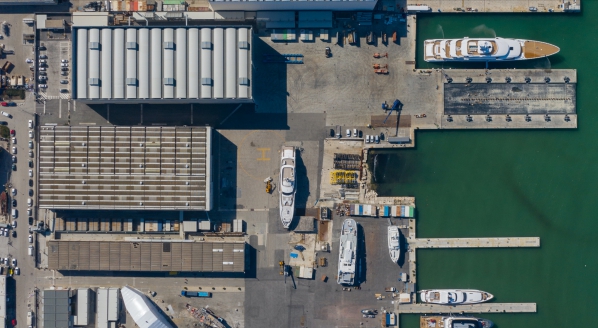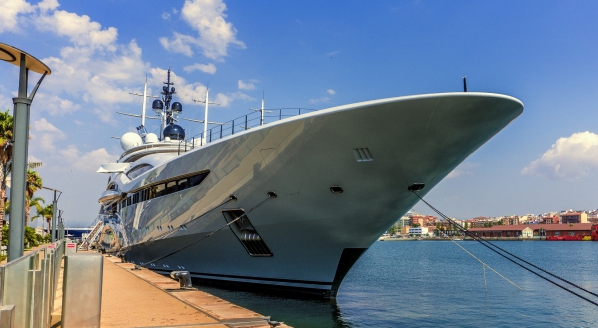Let’s face it, innovation is hard
But it is also essential, says John Venables, president & CEO of Naiad Dynamics…
From my vantage point, serving three separate and distinct marine markets, the yacht market is a special case. Consider ships that are built to serve a commercial purpose, such as ferries, crew supply vessels and all manner of essentially profit-based seagoing vessels. With operating costs central to their function, they have a clear incentive to drive innovation. Every aspect of a commercial ship’s design is focused on improving the economics, that is, improving return on investment. Whether improving fuel efficiency or passenger comfort leading to increased ridership, on-board concessions or gambling revenues, it is all about ROI.
Similarly, military ships’ sole focus on performance to best achieve the intended mission serves to inspire new and creative ways to enhance mission-critical operability. With lives at stake, the military wants, and undoubtedly deserves, the best. Military ship designs, along with all military shipboard systems, are optimised to best fulfil the ship’s mission - its purpose.
Clarity of purpose has a tendency to ‘pull’ innovation. When a problem or unsatisfactory compromise arises, while trying to satisfy the profit-making objective of a commercial ship, or the mission of a combatant, it forces hard thinking and consideration of new possibilities – essentially innovative solutions. By comparison, conceiving new creative approaches and then ‘pushing’ them as improvements, often to a sceptical audience, is harder still. Such is typically the case in the yacht market.
In contrast to an emphasis on ROI or mission-performance, luxury yachts represent significant discretionary expenditures centered around the hard-to-quantify goal of enjoyment of the sea. Efficiency? Yes. Comfort? Yes. Quiet and convenience? Yes, and Yes. Yet how much of each, and at what cost? Not so clearly defined, these metrics are highly variable among shipyards, budgets and owners’ preferences. Striking a perfect balance to satisfy all parties—paramount among them, the owner—has been an elusive quest many readers can attest to pursuing.
More than other ship markets, there is also the issue of the yacht as an investment. An owner who takes a chance on a new and innovative approach risks not only the trials and tribulations of being a first adopter of new technology, but also potentially hampering resale if his choice is not well embraced by future buyers. Industry awards and yacht club bragging rights aside, there is little tangible incentive for yacht owners to take bold chances on new innovations. Consequently, it is remarkable when new ideas break through established barriers, and naval architects, shipyards, suppliers and owners all align to embrace and invest in new technology.
As sponsor and chairman of the International Superyacht Society’s annual Technology Award, fostering innovation is near my heart. One approach to reducing the risk of innovation is via technology transfer from other industries, such as aerospace, and from the commercial and military marine sectors. The Superyacht Forum nurtures innovation in yachting, which is why at TSF 2006 I presented to the predominately yacht-focused audience a range of mono and multi-hull forms with proven motion control solutions we had applied in other ship sectors. The hope was to inspire yacht designers and naval architects to consider advanced hull forms, while reassuring them that a wide array of well-proven systems exist to reduce motion and enhance seakeeping. Since then, some progress has been made, including these notable yacht examples with active ride control, to name a few:
• M/Y Silver Cloud, a 41m Small Waterplane Area Twin Hull (SWATH) yacht. Successful in the commercial ship market and equipped with multi-axis ride control systems, adapting a SWATH hull form and its systems to a yacht, while considered a breakthrough and innovative, was relatively low risk.
• M/Y White Rabbit, at 84m the world’s largest trimaran yacht. From a motion control standpoint this yacht featured four 11.3m² active spanning foils simultaneously controlling pitch, roll and heave. Interestingly, it is a larger version of the same owner’s breakthrough 61m trimaran, which was the first of its kind and also a One2Three Naval Architects design.
• M/Y Spectre, a 69m monohull. Conventional wisdom would suggest that monohull yachts are simply roll stabilised, but this naval architect, Mulder Design, aligned with the shipyard and owner to allow this yacht to feature a ride control system to simultaneously control pitch, roll and vertical acceleration.
Especially with the recent fascination with America’s Cup foiling catamarans, it appears many designers and architects have been inspired to consider multihulls and utilise actively controlled foils such as ours to reduce resistance and enhance seakeeping. Moreover, recent foiling powerboat designs, especially in yacht tender size ranges, have captured the imagination.
Innovation may be hard, but it is alive and well. We continue to welcome this creativity, technology transfer and adaptive innovation to the yacht market.
Profile links
NEW: Sign up for SuperyachtNewsweek!
Get the latest weekly news, in-depth reports, intelligence, and strategic insights, delivered directly from The Superyacht Group's editors and market analysts.
Stay at the forefront of the superyacht industry with SuperyachtNewsweek
Click here to become part of The Superyacht Group community, and join us in our mission to make this industry accessible to all, and prosperous for the long-term. We are offering access to the superyacht industry’s most comprehensive and longstanding archive of business-critical information, as well as a comprehensive, real-time superyacht fleet database, for just £10 per month, because we are One Industry with One Mission. Sign up here.
Related news

First Amels 60 hull begins outfitting phase
The new Amels Limited Editions yacht represents a new phase in the yard’s new build programme
Fleet

The Water Revolution column
For Bill Tripp, innovation can be found across every inch of a vessel
Technology

Diplomatic-grade security and privacy
With owners wanting to spend extended periods on board, security infrastructure must enable protected business
Owner

Bering Yachts announces sale of second B145 explorer yacht
Currently in build at Bering's facility in Antalya, Turkey, the project is scheduled to be delivered in 2023
Fleet

Palumbo Superyachts expresses interest in Perini Navi
Four major shipyard groups have now expressed interest in acquiring Perini Navi through a bankruptcy auction
Business

WRF conducts research into environmental impact of superyachts
The foundation is asking captains and marinas for insight into shore power availability and usage in marinas
Business
Related news
First Amels 60 hull begins outfitting phase
5 years ago
The Water Revolution column
5 years ago
Diplomatic-grade security and privacy
5 years ago
NEW: Sign up for
SuperyachtNewsweek!
Get the latest weekly news, in-depth reports, intelligence, and strategic insights, delivered directly from The Superyacht Group's editors and market analysts.
Stay at the forefront of the superyacht industry with SuperyachtNewsweek




